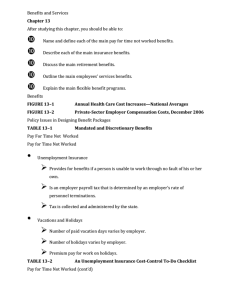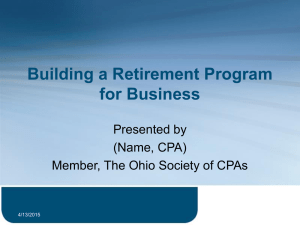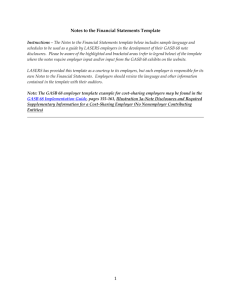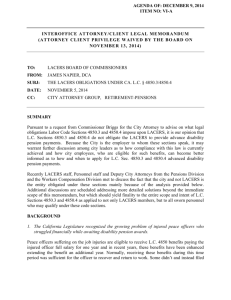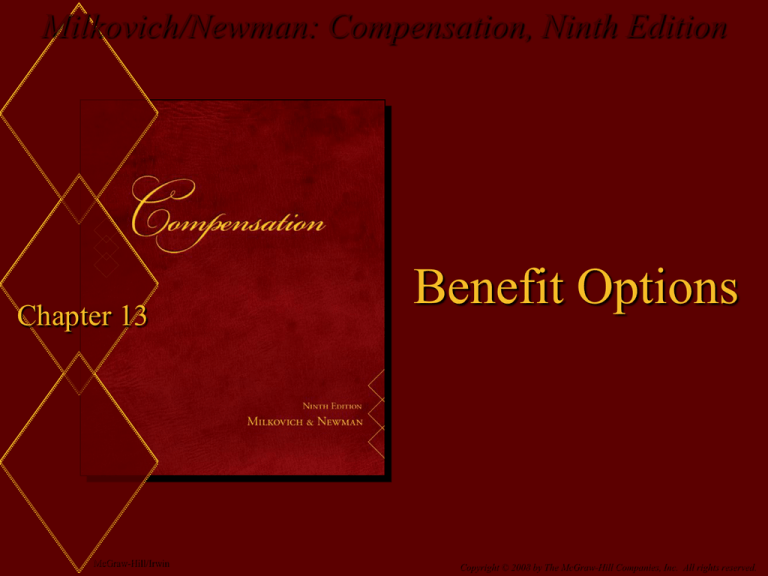
Milkovich/Newman: Compensation, Ninth Edition
Chapter 13
McGraw-Hill/Irwin
Benefit Options
Copyright © 2008 by The McGraw-Hill Companies, Inc. All rights reserved.
Chapter Topics
Legally Required Benefits
Retirement and Savings Plan Payments
Life Insurance
Medical and Medically Related Payments
Miscellaneous Benefits
Benefits for Contingent Workers
13-2
Exhibit: 13.1 Employee Benefit
Preferences
13-3
Legally Required Benefits
Workers’
Compensation
Social Security
Unemployment
Insurance
13-4
Exhibit 13.2 Categorization of Employee Benefits
13-5
Exhibit 13.3 Participation in Selected
Benefits, 2005
13-6
Overview: Workers’ Compensation
Form of no-fault insurance
– Employer liable for providing benefits to employees
that result from occupational disabilities or injuries,
regardless of fault
– Disability must be work-related
Covered by State, not Federal laws
– Employers pay premium to insurance company or
state fund
– For every dollar insurers take in to cover workplace
injuries and illnesses, they pay out $1.21 to cover
claims
13-7
Workers’ Compensation: Benefits and
Laws
Types of benefits:
– Permanent total disability and temporary total
disability
– Permanent partial disability - loss of use of a
body member
– Survivor benefits for fatal injuries
– Medical expenses
– Rehabilitation
13-8
Exhibit 13.4: Benefits by Type of
Injury: New Hampshire
13-9
Exhibit: 13.5: Commonalities in State
Workers’ Compensation Laws
13-10
Issues: Workers’ Compensation
Increased costs of medical
expenses
Cost
increases
due to . . .
Use of workers’
compensation as a surrogate
for more stringent
unemployment insurance
Cost of replacing worker wages
has risen
13-11
Workers’ Compensation
Social Security
Unemployment Insurance
Family and Medical Leave Act (FMLA)
Consolidated Omnibus Budget Reconciliation
Act (COBRA)
Health Insurance Portability and Accountability
Act (HIPAA)
13-12
Workers’ Compensation (cont.)
Retirement and Savings Plan Payments
Defined Benefit Plans
Defined Contribution Plans
Individual Retirement Accounts (IRAs)
Employee Retirement Income Security Act
(ERISA)
13-13
Social Security
Provides a basic foundation of security for
American workers and their families
For tax purposes, system is split into two
programs:
– Social Security - 6.2%
– Medicare - 1.45%
13-14
Issues: Social Security
Number
of retired workers is rising without a
corresponding increase in number of contributors
to offset costs
– Currently, 3.5 workers pay into system for each
person collecting benefits
– Within next 40 years this ratio drops to about 2 to 1
13-15
Issues: Social Security (Cont.)
Reform
options:
– Increase payroll taxes
– Decrease benefits
– Use general revenues
– Have social security go to an employee’s own
account to be earmarked of his/her personal
retirement
13-16
Benefits under Social Security
Old age or disability benefits
Benefits for dependents of retired or disabled
workers
Benefits for surviving family members of a
deceased worker, and
Lump sum death payments
13-17
Unemployment Insurance
Financing:
– Majority of states, unemployment compensation is
financed exclusively by employers that pay federal
and state unemployment insurance tax
– Federal tax amounts to 6.2 percent of the first $7,000
earned by each worker
– States additionally impose a tax above the $7,000
figure
– The extra amount a company pays depends on its
experience rating
13-18
Unemployment Insurance (cont.)
Coverage:
– Eligibility requirements to receive benefits:
Must meet State requirements for wages earned or time
worked during an established (one year) period of time
referred to as a “base period”
Must be determined to be unemployed through no fault of
your own and meet other eligibility requirements of State
law
13-19
Unemployment Insurance (cont.)
Duration:
– Benefit duration involves a complex formula that
ensures extended benefits in times of high
unemployment
When number of insured unemployed in a State reaches 6
percent
When unemployment rate is greater than 5 percent and at
least 20 percent higher than in the same period of the two
preceding calendar years and remains that way for 13
weeks
Weekly benefit amount
Controlling unemployment taxes
13-20
Family and Medical Leave Act
Coverage:
– Employers with 50 or more employees
Eligibility:
– 12 months employment with employer in which
employee works 1,250 hrs
Qualifying
events:
– Specified family or medical reasons
13-21
Family and Medical Leave Act (cont.)
Eligibility:
– Employee must have worked at least 1,250 hours
for the employer in the previous year
Common reasons
for leave:
– Caring for an ill family member or adopting a Child
13-22
Consolidated Omnibus Budget
Reconciliation Act (COBRA)
Coverage:
– Employers with 20 or more employees
Eligibility:
– Provides current and former employees and their
spouses and dependents with temporary extension of
health care benefits
Qualifying events:
– Specified events (e.g. layoffs)
Qualifying event
coverage:
– 18 to 36 months, depending on category of qualifying
event
13-23
Health Insurance Portability and
Accountability Act (HIPPA)
Key provisions
– Lessens an employer’s ability to deny coverage for a
preexisting condition
– Prohibits discrimination on the basis of healthrelated status
– Provides stringent privacy provisions
13-24
Retirement and Savings Plan Payments
Employees rank pensions in the top
three of all benefits in terms of
importance
Defined benefit plans
Defined contribution plans
Individual Retirement Accounts (IRAs)
Employee Retirement Income Security
Act (ERISA)
13-25
Defined Benefit Plans
Employer
provides a specific pension level
defined in terms of:
– Fixed dollar amount or
– Percentage-of-earnings amount that may vary with
years of seniority
Employer
finances this obligation by:
– Following an actuarially determined benefits formula
and
– Making current payments that will yield the future
pension benefit for a retiring employee
13-26
Defined Benefit Plans (Cont.)
Determination of benefit levels
– Average earnings at end of tenure (last 3 – 5 years)
or
– Average career earnings or
– Fixed dollar amount not dependent on earnings
13-27
Defined Contribution Plans
Require specific contributions by employer
Final benefit received by employees is unknown
– Dependent on investment success of plan manager
Three popular forms of these plans
– 401 (k) plan
– Employee Stock Ownership Plan (ESOP)
– Profit sharing
Can be considered a defined contribution plan if distribution
of profits is delayed until retirement
Cash balance plans hybrid of defined benefit
and defined contribution plans
13-28
Exhibit. 13.10: Relative Advantages of
Different Pension Alternatives
13-29
Individual Retirement Accounts (IRAs)
Tax-favored retirement savings plan that
individuals can establish themselves
– IRAs are used mostly to store wealth accumulated in
other retirement vehicles, rather than as a way to
build new wealth
13-30
Employee Retirement Income Security
Act (ERISA)
Eligibility: Employees at least 21 years old
– Employers may require 6 months of service as a
precondition for participation
Vesting: Length of time employee must work
for employer before entitled to employer
payments to plan
– Any contributions made by an employee to a
pension fund are immediately and irrevocably vested
– Employer’s contribution must vest according to two
formulas
13-31
Employee Retirement Income Security
Act (ERISA) (cont.)
Portability: Issue for employees moving to new
companies
– Law does not require mandatory portability of
private pensions
– An employer may voluntarily agree to permit
portability (pension rights must be vested)
Pension Benefit Guaranty Corporation (PBGC):
Insures payment of certain pension plan benefits
13-32
How Much Retirement Income to
Provide?
What level of retirement income should be set as
a target?
Should social security benefits be factored in
when considering level of retirement income?
Should other post-retirement income sources be
integrated with pension?
How large a role should seniority play in
determining pension level?
What can a company afford?
13-33
Life Insurance
One of the most common employee benefits
87% of medium and large companies offer life
insurance
Most companies offer term policies
– Value of one to two times an employee’s salary
– Most plan premiums paid completely by employer
– Varying amounts of additional coverage often an option
13-34
Health and Medical Benefits
General Health
Care
Health Care:
Cost Control
Strategies
Short- & LongTerm Disability
Dental
Insurance
Vision Care
13-35
General Health Care
An
employer’s share of health care costs is
contributed into one of six health care systems:
– Community-based system
– Commercial insurance plan
– Self-insurance
– Health maintenance organization (HMO)
– Preferred provider organization (PPO)
– Point-of-service plan (POS)
13-36
Controlling Health Care Costs: Three
Strategies
Motivate
employees to change their demand for
health care via changes in either design or
administration of policies
Change
structure of health care delivery systems
and participate in business coalitions
– HMOs
– PPOs
13-37
Controlling Health Care Costs: Three
Strategies (cont.)
Promote preventive health programs
– No-smoking policies
– Healthy food in cafeterias and vending machines
13-38
Controlling Health Care Costs:
Strategy One
Practices
related to design and administration of
health plan
– Increase deductibles
– Change coinsurance rates
– Reduce maximum benefits
– Coordinate benefits with employees and spouses
13-39
Controlling Health Care Costs: Strategy
One (cont.)
– Audit health care charges
– Require preauthorization for visits to facilities
– Require mandatory second opinion for procedures
– Use intranet technology to allow employees access
to online benefit information
13-40
Short- and Long-Term Disability
Workers’ compensation covers disabilities that
are work-related
Social security has provisions for disability
income to those who qualify
Private sources of disability income:
– Employee salary continuation plans
– Long-term disability plans
13-41
Miscellaneous Benefits
Paid Time Off
During Working
Hours
Payment for Time
Not Worked
Child Care
Elder Care
Legal Insurance
Domestic Partner
Benefits
13-42
Paid Time Off During Working Hours
Rest periods
Lunch periods
Wash-up time
Travel
Clothes-change time
Get-ready time
13-43
Pay for Time Not Worked
Paid vacations and
payments in lieu of vacation
Payments for holidays not
worked
Paid sick leave
Other
– National guard
– Army, or other reserve duty
– Jury duty
– Voting pay allowances
– Personal reasons
13-44
Exhibit 13.18: Employees Receiving
Leave Time Benefits
13-45
Exhibit 13.19: Benefits Received: FullTime vs. Contingent Employees
13-46

